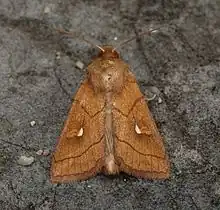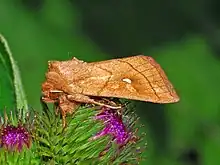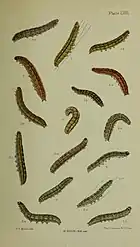Mythimna conigera
Mythimna conigera, the brown-line bright-eye, is a moth of the family Noctuidae.
| Brown-line bright-eye | |
|---|---|
 | |
| Mythimna conigera. Dorsal view | |
 | |
| Side view | |
| Scientific classification | |
| Domain: | Eukaryota |
| Kingdom: | Animalia |
| Phylum: | Arthropoda |
| Class: | Insecta |
| Order: | Lepidoptera |
| Superfamily: | Noctuoidea |
| Family: | Noctuidae |
| Genus: | Mythimna |
| Species: | M. conigera |
| Binomial name | |
| Mythimna conigera (Denis & Schiffermüller, 1775) | |
| Synonyms | |
| |
Distribution
This species can be found in Europe and there is a disjunct population in the Sind Valley, Kashmir named subspecies angulifera (Moore, 1881) and east across the Palearctic from Asia Minor, Armenia, Central Asia, Siberia to Japan. [1][2]
Habitat
These moths inhabit open habitats, wet and dry meadows, in montane and subalpine areas. [3]
Technical description and variation
The wingspan is 30–35 mm. [4] Forewing smooth pale ochreous suffused with brown except along costa; Forewing pale fulvous suffused with darker: lines fine, brown; inner line angled on submedian fold: outer sinuate, nearly parallel to outer margin; orbicular and reniform stigmata pale, indistinct, except lower lobe of reniform, which is marked by a snowwhite spot, and is often surrounded by a grey cloud: hindwing pale rufous, darker towards termen: -suffusa Tutt is a melanic form, without any yellow tint, from North England and W. Ireland.

Larva dull yellow brown; dorsal line white, with dark edges: subdorsal line black; lateral lines white flecked with red, with a broad brown stripe running beneath them and above the black spiracles.[5]
Biology
The moth flies from June to July depending on the location. [4] The larvae feed on various grasses, including Dactylis glomerata, Elymus repens.[6] Phalaris arundinacea, Calamagrostis purpurea and Festuca species. [1]
References
- Funet
- Fauna Europaea
- Pieris.ch (in German)
- UKmoths
- Seitz, A. Ed., 1914 Die Großschmetterlinge der Erde, Verlag Alfred Kernen, Stuttgart Band 3: Abt. 1, Die Großschmetterlinge des palaearktischen Faunengebietes, Die palaearktischen eulenartigen Nachtfalter, 1914
- "Robinson, G. S., P. R. Ackery, I. J. Kitching, G. W. Beccaloni & L. M. Hernández, 2010. HOSTS - A Database of the World's Lepidopteran Hostplants. Natural History Museum, London".
External links
- Lepiforum (in German)
- Paolo Mazzei, Daniel Morel, Raniero Panfili Moths and Butterflies of Europe and North Africa
- Naturhistoriska risksmuseet (in Swedish)